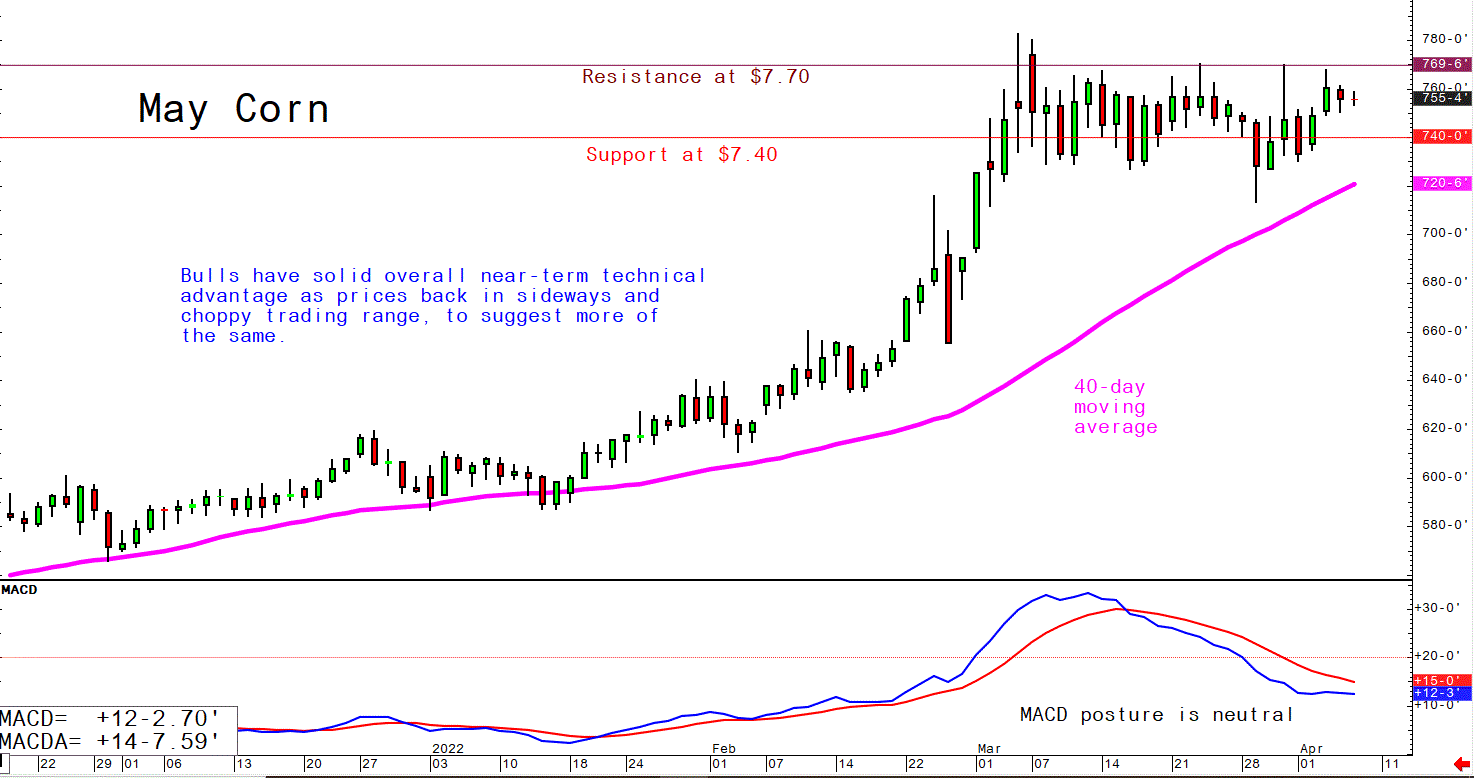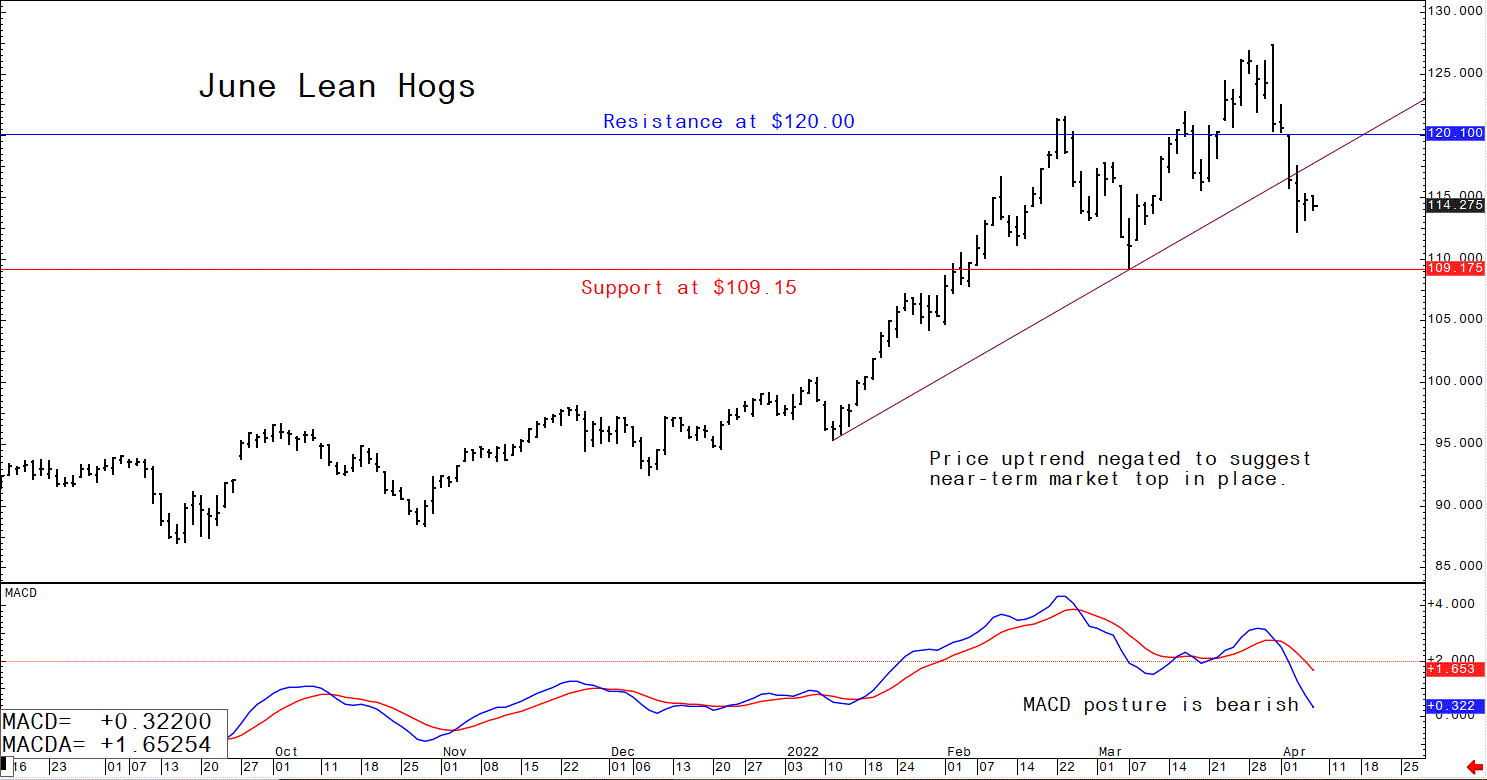



Pig outlook: Lean hog futures in steep price downdraft, China’s Covid policy risks ag crisis, food shortages
Analyst Jim Wyckoff shares highlights from the global swine market.The pig traders’ perspective: The lean hog futures market bulls have faded fast the past week, as prices Wednesday hit a four-week low, to suggest a near-term market top is in place. However, the hog market bulls are hoping the seasonal tendencies for improving grilling season demand and declining hog supplies in the weeks ahead will keep a floor under the market. The June contract’s sizeable discount to last year’s cash high at $122.68 looks excessive as well, especially considering the anticipated annual decline of 3% to 4% in spring hog supplies, according to USDA. Bears expect reduced pork demand to limit the market’s upside potential during the coming weeks, with the bulk of that looking likely to stem from substantially reduced export buying from comparable spring 2021 levels.
Latest US Department of Agriculture (USDA) reports, and other news
US pork sales post solid gains; beef slips again
USDA Thursday reported US beef net sales of 14,000 MT for 2022 were down 39 percent from the previous week and 43 percent from the prior 4-week average. Increases were primarily for Japan (6,500 MT, including decreases of 400 MT), South Korea (3,900 MT, including decreases of 800 MT), Mexico (800 MT), Taiwan (700 MT, including decreases of 100 MT), and Hong Kong (500 MT). Exports of 19,300 MT were down 5 percent from the previous week and 18 percent from the prior 4-week average. The destinations were primarily to Japan (5,400 MT), South Korea (5,400 MT), China (3,400 MT), Taiwan (1,500 MT), and Mexico (900 MT).
US pork net sales of 41,200 MT for 2022 were up 49 percent from the previous week and 44 percent from the prior 4-week average. Increases primarily for Mexico (13,200 MT, including decreases of 300 MT), China (13,000 MT, including decreases of 400 MT), Japan (5,100 MT, including decreases of 600 MT), Colombia (2,300 MT), and South Korea (2,300 MT, including decreases of 1,000 MT), were offset by reductions for Chile (100 MT). Exports of 29,000 MT were down 5 percent from the previous week, but up 2 percent from the prior 4-week average. The destinations were primarily to Mexico (13,500 MT), Japan (3,800 MT), China (3,600 MT), South Korea (2,300 MT), and Canada (1,400 MT).
USDA grants funds for meatpacking industry study
A professor at the University of Nebraska-Lincoln (UNL) received funding from USDA to study various factors that have affected the meat supply chain since the Covid-19 pandemic began. Azzeddine Azzam at UNL received the USDA funding via the National Institute of Food and Agriculture to study industry conduct during the Covid-19 plant shutdowns and evaluate the economic developments from expanding local meat processing through the start of small packing operations. “When we add more regional or local capacity to the industry, either through opening new plants or expanding the capacity of existing plants, that is going to restructure the industry,” Azzam said. “The questions that I will address are: Will the restructuring make the industry more resilient to capacity disruptions in the event of another pandemic? What are the short-term and long-term consequences for the cattle feeding industry?”
China’s zero-Covid policy risks causing agricultural crisis and food shortages
China’s strict Covid lockdowns are exacerbating serious shortages of fertilizer, labor and seeds, just as many of the country’s biggest agricultural provinces prepare for their crucial spring planting season, reports the Financial Times. According to official data, as many as a third of farmers in northeastern Jilin, Liaoning and Heilongjiang provinces have insufficient agricultural inputs after authorities sealed off villages to fight the pandemic. The three provinces account for more than 20% of China’s grain production. According to the Jilin provincial government, about one-third of farmers did not have enough fertilizer at the end of March — only about three weeks before they were supposed to begin planting. Farmers and factory managers have blamed the disruption on China’s uncompromising zero-Covid policy, under which authorities have adopted tough controls ranging from traffic bans to local business shutdowns. An executive at Genliduo, a leading fertilizer producer in Hebei province, said his firm was having “lots of difficulty” shipping to customers and securing raw materials. The executive added that the problem was industry-wide and many smaller producers had suspended operations.
US pork producers to press lawmakers on public policies
Preparing for and preventing foreign animal diseases, addressing an agricultural labor shortage, and increasing pork exports are the top public policy issues pork producers will lobby their congressional lawmakers on over the next two days. During the spring Capitol Hill fly-in of the National Pork Producers Council (NPPC), nearly 100 producers from across the country are expected to participate — in person for the first time in two years — in NPPC’s Legislative Action Conference.
Producers will urge lawmakers to support additional funding for foreign animal disease prevention and preparedness efforts, particularly around African swine fever (ASF). Last July, ASF was detected in the Western Hemisphere for the first time in more than 40 years. NPPC is requesting funding for fiscal 2023 for additional U.S. Customs and Border Protection agricultural inspectors; for the National Animal Health Laboratory Network, which provides disease surveillance and diagnostic support in cases of large-scale animal disease outbreaks; and for additional staff for the USDA Animal and Plant Health Inspection Service’s Veterinary Services.
To address an ongoing labor shortage, producers will ask Senate and House members to expand the H-2A visa program to year-round agricultural workers, including packing plant employees. Currently, the visa only allows for temporary, seasonal farm laborers. The pork industry also supports providing a pathway to legal status for foreign-born agricultural workers already in the United States.
Pork producers also will lobby lawmakers on the importance of trade to the industry, urging the Biden administration to join the Comprehensive and Progressive Agreement for Trans-Pacific Partnership (CPTPP). The 11-country CPTPP has almost 500 million consumers and $13.5 trillion of GDP. The United States was part of a previous agreement, the Trans-Pacific Partnership (TPP), but President Trump withdrew from the TPP before it became effective. Producers also will request that the administration negotiate a more ambitious Indo-Pacific Economic Framework deal, one that includes agriculture and addresses nontariff barriers to U.S. products, including pork.
The next week’s likely high-low price trading ranges:
June lean hog futures--$109.15 to $120.00, and with a sideways bias
May soybean meal futures--$448.10 to $494.70, and with a sideways bias
May corn futures--$7.13 1/2 to $7.82 3/4, and a sideways bias
Latest analytical daily charts lean hog, soybean meal and corn futures












